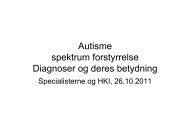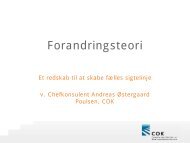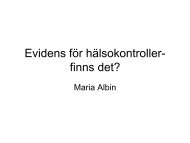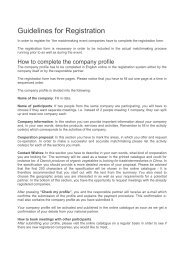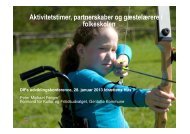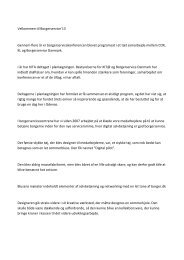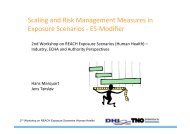11-13 May 2012 Helsingør - Denmark www.networkbio.org
11-13 May 2012 Helsingør - Denmark www.networkbio.org
11-13 May 2012 Helsingør - Denmark www.networkbio.org
Create successful ePaper yourself
Turn your PDF publications into a flip-book with our unique Google optimized e-Paper software.
KRzYSzTOf fUJAREWICz<br />
SILESIAN UNIVERSITY Of TEChNOLOGY, POLAND<br />
Optimal sampling for parameter estimation of cell signaling pathway models based on multivariate measurements<br />
Mathematical modeling of cell signaling pathways became a very important and challenging problem<br />
in recent years. The importance comes from possible application of obtained models. It may help us to<br />
understand phenomena appearing in single cells and in cell populations. Furthermore, it may help us with<br />
discovering new drug therapies.<br />
Mathematical models of cell signaling pathways take different forms. The most popular way of mathematical<br />
modeling is to use a set of nonlinear ordinary differential equations (ODEs).<br />
Usually there are many hypotheses about the structure of the model (set of variables and set of phenomena).<br />
It leads to several rival models and one of them should be chosen among others. This choice may be<br />
supported by so called T-optimal experiment design.<br />
The next step, estimation of the model’s parameters, is also very complicated because of the nature of<br />
measurements. The blotting technique usually gives only semi-quantitative observations which are very<br />
noisy and they are collected only at limited number of time moments. Once more, the accuracy of parameter<br />
estimation may be significantly improved by proper experiment planning.<br />
We present two-stage experiment plan optimization algorithm. The first step is gradient-based D-optimization<br />
procedure to find all stationary points. The second step is pair-wise replacement for finding optimal<br />
numbers of replicates of measurements. The algorithm is applied to one of cell signaling pathway model,<br />
known from the literature.<br />
For multivariate measurements the presented approach gives, in general, different optimal time points for<br />
different variables. In practice it is better to take measurements at the same time points. We show how this<br />
constraint influences the final result of optimization.<br />
This work has been supported by Polish Ministry of Education and Science under grant N N514 4<strong>11</strong>936.<br />
abStractS For PoSterS abStractS For PoSterS<br />
IA VAN DIJK, MJ OUDhOff, J VAN DE AMEIDE, JGM BOLSChER, ECI VEERMAN.<br />
DEPARTMENT Of ORAL BIOChEMISTRY, ACADEMIC CENTRE fOR DENTISTRY AMSTERDAM (ACTA), UNI-<br />
VERSITY Of AMSTERDAM AND VU UNIVERSITY AMSTERDAM, ThE NEThERLANDS.<br />
Histatin from saliva promotes wound healing: Salivary peptide histatin induces GPCR- and ERK-dependent<br />
cell migration<br />
Wounds in the oral cavity heal faster than at other sites in the human body, e.g. the skin. Several factors<br />
have been implicated in this phenomenon, including the presence of saliva, which in rodents is a reservoir of<br />
many growth factors, such as epidermal growth factor (EGF) and nerve growth factor (NGF). In humans the<br />
identity of the involved compounds has remained elusive, since the saliva concentration of growth factors is<br />
1,000 to 100,000 times lower than in rodent saliva. The present study was aimed at the identification of the<br />
factor(s) responsible for the alleged wound healing power of saliva, and a first characterization of the cellular<br />
processes.<br />
Using an in vitro scratch assay we found that human saliva is able to induce epithelial cell migration, without<br />
involvement of EGF. By testing protein fractions of human saliva obtained by HPLC, we identified salivary<br />
histatins as the main migration-inducing factors in saliva. The ᴅ-enantiomer of histatin is not active, pointing<br />
towards the involvement of a stereospecific receptor. N-to-C terminal cyclization of histatin potentiates the<br />
molar activity approximately 1,000-fold, suggesting that the activation of the putative receptor requires a<br />
specific spatial conformation of the peptide. Histatin activity was abolished both by inhibition of mitogen activated<br />
protein kinases ERK1/2 and MEK, and by pertussis toxin, an inhibitor of G protein coupled receptors,<br />
suggesting the involvement of a GPCR-dependent ERK1/2 signaling pathway. Using a functional phosphokinase<br />
assay, we found, in addition, activation as well as inhibition of a large number of other phosphokinases<br />
upon treating epithelial cells with histatin.<br />
Conclusion: Our results emphasize the importance of histatin in human saliva for tissue protection and recovery,<br />
and establish the experimental basis for the development of synthetic histatins as novel wound-healing<br />
agents.<br />
34 / INB <strong>2012</strong> • <strong>11</strong>-<strong>13</strong> <strong>May</strong> <strong>2012</strong> <strong>www</strong>.<strong>networkbio</strong>.<strong>org</strong> / 35




